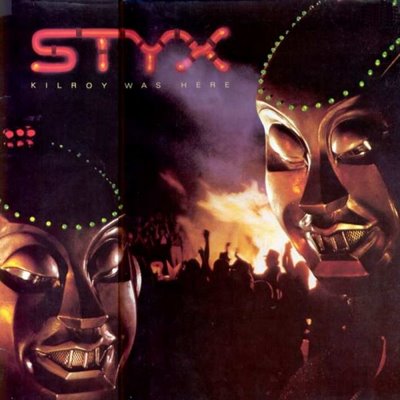
Kilroy Was Here (1983)

1.Mr. Roboto
2.Cold War
3.Don't Let It End
4.High Times
5.Heavy Metal Poisoning
6.Just Get Through This Night
7.Double Life
8.Haven't We Been Here Before
9.Don't Let It End (Reprise)
More than two years had passed since the last Styx release—an eternity by early '80s standards. In an era before MTV and internet speculation, the band’s prolonged silence created an odd vacuum. Coming off the enormous success of Paradise Theatre, the anticipation for a follow-up became unbearable. So when radio DJs finally announced a new Styx single was about to drop, expectations were sky-high. And then we heard it: “Domo Arigato, Mr. Roboto”. Followed by the curious echo: “Kilroy! Kilroy!”. Eyebrows were raised. Confusion reigned. Was the hell was this?
One thing could not be denied: Dennis DeYoung had been the band’s navigator for years, and his instincts had proven correct time and again. It would have been hard to bet against him, given how successfully he’d steered them to gold and platinum in the past. So the band—perhaps reluctantly—went along with his latest vision. But this time, the gamble didn’t quite pay off.
Wanting to elevate the band into even grander artistic territory, DeYoung devised an elaborate sci-fi narrative. Kilroy Was Here wasn’t just an album; it was part of a larger concept—complete with an expensive 11-minute film to be screened before concerts. In this dystopian tale, rock music is outlawed for its “dangerous influence.” DeYoung plays the titular Kilroy, a jailed rock star battling the rise of a conservative anti-music crusade led by J.Y.—yes, seriously—who portrays the robotic, moralistic antagonist. Shaw enters the scene as the young rock savior. There are robots (“Robotos”), censorship, fried chicken references, and a plot that’s best left to theater students with a fondness for irony.
Yet for all its conceptual bluster, the band’s lack of enthusiasm was plain. Only about half of the album’s tracks connect meaningfully with the overarching story. DeYoung himself delivers the chart-busting Don’t Let It End, a syrupy ballad entirely divorced from the robot apocalypse. It's vintage Dennis—sentimental, melodic, and impossible to link to the sci-fi concept in any meaningful way.
Tommy Shaw, meanwhile, made no secret of his disdain for the project, and his contributions reflect that detachment. Yet paradoxically, his songs shine the brightest. Cold War is dated by its synthetic flourishes, but not without its charm. Just Get Through This Night may be his most vulnerable composition—heart-wrenching and beautifully introspective, akin to Love in the Midnight from Cornerstone. The anguish is palpable. His third number, Haven’t We Been Here Before, is another strong entry, at odds with the futuristic absurdity of the album’s concept, but all the better for it.
James Young tries gamely to play along. His two tracks stick closer to DeYoung’s storyline. Heavy Metal Poisoning is more parody than prophecy, with J.Y. bellowing anti-metal rhetoric in a full-blown metal track—unintentionally hilarious. Double Life is more intriguing: slow, ominous, and ambiguous enough to allow deeper interpretation. Whether Young’s character is hiding dark secrets or simply fulfilling the narrative is unclear—but it works either way.
And then, of course, there’s Mr. Roboto. Love it or loathe it, you know it. With its synthesizers, robotic vocals, and infectious chorus, the song alienated long-time fans who preferred the harder edge of Renegade or Miss America. But Mr. Roboto became a massive hit, going Top 5 and selling over a million copies. Like Y.M.C.A. or The Macarena, it’s become one of those cultural artifacts that people secretly enjoy behind closed curtains.
DeYoung’s second conceptual piece, High Time, falls short in comparison. Heavy-handed and didactic, it feels less like a song and more like a lecture. In trying to hammer home the album’s message, DeYoung lost the musical spark.
When taken on the road, Kilroy Was Here divided audiences. Some praised the rock-theatre spectacle, while others just wanted to hear the hits without a storyline. The pressure ultimately fractured the band. Shaw quit halfway through the tour, not returning for over a decade. In hindsight, Kilroy Was Here may not have been the commercial catastrophe some feared—it sold well and had hits—but artistically, it marked the beginning of the end for the original incarnation of Styx. Still, as misguided as the concept may have been, you can’t help but admire the ambition. It was a strange, glittering detour. And for better or worse, it was an interesting ride.
Go back to the main page
Go To Next Review